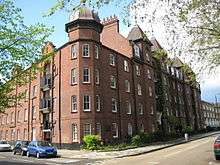East End Dwellings Company
The East End Dwellings Company was a Victorian philanthropic model dwellings company, operating in the East End of London in the latter part of the nineteenth century. The company was founded in principle in 1882 by, among others, Samuel Augustus Barnett, vicar of St Jude's Church, Whitechapel;[1][2] it was finally incorporated in 1884.[3][4]
| Public Company | |
| Industry | Housing |
| Founded | Whitechapel, London, United Kingdom (1882) |
| Founder | Samuel Barnett |
| Headquarters | London |
Area served | London Borough of Tower Hamlets |
Key people | Samuel Barnett, Beatrice Potter (estate manager), Ella Pycroft (estate manager), Maurice Eden Paul |
| Products | Model dwellings |
Its aim was to "house the very poor while realizing some profit",[5] "their particular purpose being to erect blocks of dwellings, to be let by the room, so that the poorest class of labourers could be accommodated".[6] Unlike many of the model dwellings companies, the EEDC offered accommodation to the casual poor and day labourers.[7]
The company's first venture was Katharine Buildings in Aldgate, followed by a number of schemes in Bethnal Green, London. They went on to build around the East End. Along the principles of Octavia Hill's schemes, the company used female rent-collectors, including Beatrice Potter (later Webb), one of the founders of the London School of Economics & Political Science[8] and Ella Pycroft, who ran the Buildings alongside Maurice Eden Paul.[9]
Buildings

- Katharine Buildings - Cartwright Street, Aldgate[10][11]
- Museum House - Green Street, Bethnal Green (1888)
- Tankerton Street, King's Cross (1892)
- Meadows Dwellings - Mansford Street (1894)
- Ravenscroft Dwellings - Columbia Road (1897)
- Dunstan Houses - Stepney Green (1899)
- Whidborne Buildings - Tonbridge Street, Kings Cross (1890s)[12]
- Mendip Houses - Kirkwall Place, Bethnal Green (1900)
- Shepton Houses (1900)
- Merceron Houses (1901)
- Montfort House (1901)
- Gretton Houses (1901)
- Thornhill Houses - Barnsbury (1902)[13]
- Evesham House - Old Ford (1905)
- Globe Road/Cyprus Street block - Bethnal Green (1906)
See also
References
- Mrs. H. O. Barnett, Canon Barnett, His Life, Work and Friends, 1918, vol. i, pp. 129–40
- Whelan, R. (ed.) (1998) Octavia Hill and the Social Housing Debate: Essays and Letters by Octavia Hill, London: Civitas
- O'Day, p.151
- Connor and Critchley
- Bethnal Green: Building and Social Conditions from 1876 to 1914', A History of the County of Middlesex: Volume 11: Stepney, Bethnal Green (1998), pp. 126-132. Date accessed: 24 March 2011
- 'The Fossan (Keate and Tonge) estate', Survey of London: volume 27: Spitalfields and Mile End New Town (1957), pp. 245-251. Date accessed: 24 March 2011
- O'Day, p.157
- "Susannah Morris, Social Policy: From the Victorians to the Present Day". Archived from the original on 2012-05-10. Retrieved 2011-03-24.
- Mackenzie, N. (ed.) The Letters of Sidney and Beatrice Webb: Volume 1, Apprenticeships 1873-1892, p.46-7
- O'Day, Rosemary (2004). Caring or controlling? The East End of London in the 1880s and 1890s. In: Emsley, Clive; Johnson, Eric and Spierenburg, Pieter eds. Social control in Europe: Volume 2, 1800-2000. Columbus, Ohio, USA: Ohio State University Press, pp. 149–166.
- AIM25 WEBB, Beatrice, 1858-1943: Aldgate papers
- "Kings Cross Railway Lands Group" (PDF). Archived from the original (PDF) on 2012-04-25. Retrieved 2011-10-13.
- Thornhill Houses Tenants and Residents Association
Further reading
- Connor, JE and Critchley, BJ (1984) The Red Cliffs of Stepney: History of Buildings erected by the East End Dwellings Co. 1885-1949, Connor and Butler
- O'Day, Rosemary (2004). Caring or controlling? The East End of London in the 1880s and 1890s. In: Emsley, Clive; Johnson, Eric and Spierenburg, Pieter eds. Social control in Europe: Volume 2, 1800-2000. Columbus, Ohio, USA: Ohio State University Press, pp. 149–166.